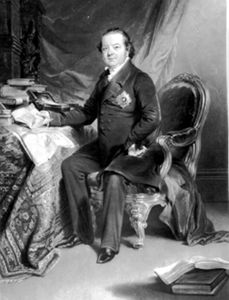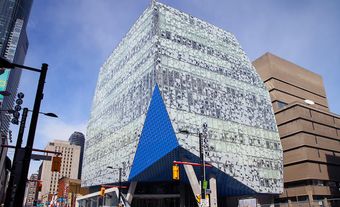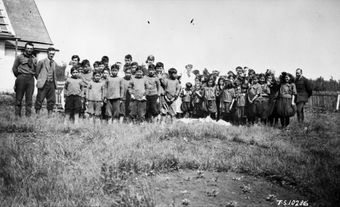Adolphus Egerton Ryerson, Methodist minister, educator (born 24 March 1803 in Charlotteville Township, Norfolk County, Upper Canada; died 18 February 1882 in Toronto, Ontario). Egerton Ryerson was a leading figure in education and politics in 19th century Ontario. He helped found and edit the Christian Guardian (1829) and served as president of the Methodist Church of Canada (1874–78). As superintendent of education in Canada West, Ryerson established a system of free, mandatory schooling at the primary and secondary level — the forerunner of Ontario’s current school system. He also founded the Provincial Normal School (1847), which eventually became the Ontario Institute for Studies in Education (OISE). Ryerson also served as principal of Victoria College, which he helped found in 1836 as the Upper Canada Academy. He was also, however, involved in the development of residential schools in Canada. This has led to increasing calls to rename Ryerson University (now Toronto Metropolitan University) and other institutions named in his honour.

Early Life and Family
Egerton Ryerson was born into a prominent Loyalist family in 1803. His father, Joseph Ryerson, was an officer in the American Revolutionary War (1775–83). He left for Canada and settled as a half-pay officer near Vittoria, Upper Canada, in the 1790s. During the War of 1812, Joseph fought against the Americans, as did his three oldest sons. Egerton grew up in Norfolk County among those who were deeply loyal to Great Britain. He attended the London District Grammar School in Vittoria.
Methodism
Egerton Ryerson’s father, Joseph, belonged to the Anglican Church. But his mother, Mehetable Stickney Ryerson, had Methodist inclinations. (Methodism began as a movement within the Anglican Church. It became a separate church in 1795.) Egerton absorbed his mother’s Methodist sympathies; they were reinforced by the teachings of travelling Methodist missionaries (also known as circuit riders), who preached evangelical Christianity.
Ryerson’s mother joined the Methodist Church in 1816, along with two of his brothers, to the disappointment of his Anglican father. Several years later, when Ryerson applied for membership in his local Methodist society at age 18, his disapproving father insisted that he leave home. For two years (1821–23), Ryerson worked as an assistant to his brother George. George was schoolmaster at the London District Grammar School. Egerton returned home for a short time in 1823. He then left for Hamilton to attend the Gore District Grammar School to study law.

After recovering from a severe illness that interrupted his studies, Ryerson’s commitment to the Methodist faith grew. In 1825, he became a Methodist missionary. He rode on horseback on the York and Yonge Street circuits and lived as a missionary at the Credit River (now Mississauga). There, he worked and lived alongside Ojibwa people. He learned to speak the language and became a respected teacher. He befriended Kahkewaquonaby (Sacred Feathers), also known as Peter Jones, the first Indigenous Methodist missionary. In 1826, at a council meeting, Ryerson received the Ojibwa name Cheechock (Bird on a Wing).
Ryerson first came to prominence in 1826. He led an attack on the Church of England. It claimed to be the official church of the colony and exclusive beneficiary of the Clergy Reserves (a portion of lands set aside by the Constitutional Act of 1791 for the support of Protestant clergy). Ryerson wrote a counterattack to an argument by Anglican bishop John Strachan that Methodists were pro-American and therefore disloyal to Britain. Ryerson thus emerged as a leading voice for the Methodist Church.
In 1827, Ryerson was fully ordained as a minister of the Methodist Episcopal Church. He emerged as the leading Methodist spokesman. He was a major figure in the Reform cause for religious freedom. He was the first editor of the Methodist newspaper, The Christian Guardian. Ryerson used the press to promote Methodism. He continued as an influential political adviser for the rest of his life. Between 1874 and 1878, he served as president of the Methodist Church of Canada.

Politics
Ryerson based his long and active public career on a consistent yet often misunderstood political outlook. His views were a mix of loyalty to British-Canadian institutions; a conservative mistrust of radical philosophy; a liberal optimism in humankind; and a deep and abiding religious commitment.
In Ryerson’s early career, politics in Upper Canada was polarized by Tory and Reform controversy. Ryerson was condemned for not belonging neatly to either camp. He opposed the Family Compact (which was led by Anglican bishop John Strachan and Chief Justice John Beverley Robinson). He also sympathized early on with William Lyon Mackenzie’s ideals of civil equality, such as the secularization of the Clergy Reserves.
However, Ryerson publicly criticized the Reform movement in the mid-1830s. He believed it had become too radical. He also opposed Mackenzie’s violent methods in the rebellion of 1837. During the 1840s, Ryerson continued his active role in politics. Much to the anger of his Reform allies and many Methodists, he supported Governor Charles Metcalfe against Reformers Robert Baldwin and Louis-Hippolyte LaFontaine in 1844. He appeared to have joined the Tories, whom he had opposed for nearly 20 years. He was considered for a role in Metcalfe’s administration; he was ultimately offered the role of superintendent of education for Canada West. He fit naturally into the moderate, Liberal-Conservative alliance after the mid-1850s. In fact, he helped create its ideological framework through the educational system he fostered.

Education Reform
In 1844, Ryerson was appointed superintendent of education for Canada West. He held this post until retiring in 1876. In 1844 and 1845, he toured Europe to study different school systems. Based on his findings, he wrote his Report on a system of public elementary instruction for Upper Canada (1846). In this report, he made recommendations for improvements to the educational system. Many of his points were adopted in the first two Common Schools Acts (1846, 1850).
Ryerson believed that poverty should not be a roadblock to education and that Canada West should have a free and mandatory public education system. He also believed that schools should teach Christian morals to improve the individual and help society progress. This new educational system, the forerunner of Ontario’s current school system, would be overseen by the chief superintendent of schools, who would set common standards across Canada West. Ryerson recommended an efficient system of school inspections to maintain these standards. He also recommended standard textbooks across the system and the creation of an Educational Depository; it supplied textbooks and educational material to schools at affordable prices. A Journal of Education was created to help keep teachers up to date.
Ryerson was one of the founders of the Provincial Normal School (1847). It was the first teacher’s college in Toronto. It later became the Toronto Teachers’ College and then the Ontario Institute for Studies in Education (OISE). Ontario gained a new, accessible primary and secondary school system based on these principles. They culminated in the Common Schools Act of 1871, which established free and mandatory schooling.
Ryerson was also involved in post-secondary education. He promoted denominational universities as the pinnacle of the educational process. He believed that both the individual and society could be improved through religion and education. Ryerson was a driving force behind the Methodist Church’s establishment of Upper Canada Academy in Cobourg in 1832. In 1841, it became a university and was renamed Victoria College. The following year, Ryerson was appointed principal. He taught at the college and was remembered by former students as an intelligent, exacting and occasionally severe teacher. By 1892, ten years after Ryerson’s death, Victoria College was integrated into the University of Toronto. The campus then moved to Toronto.
During his long career in education, Ryerson wrote numerous pamphlets and texts, as well as an autobiography and several works on the history of the province. He also served as editor of the Journal of Education for Upper Canada between 1848 and 1875.

Residential Schools
While advocating for free and compulsory education, Ryerson supported different systems for Indigenous and non-Indigenous students. He supported the system of educating Indigenous students separately and converting them to Christianity, in order to assimilate them into Euro-Canadian culture. Such schools had existed in New France since the 17th century. The first residential school in Upper Canada began operating in Brantford in 1831. Ryerson agreed with the findings of the Bagot Commission Report (1842–44); it recommended manual labour schools where Indigenous children were separated from their parents in order to achieve assimilation.
In 1847, the Indian Affairs Branch of the government asked Ryerson to write a report on the best methods of operating residential schools. The report was part of a larger document entitled Statistics Respecting Residential Schools. In this report, Ryerson recommended that Indigenous students continue to be educated in separate, agriculturally based boarding schools with religious and English language instruction. The schools would train students to be farmers and provide an education on par with common schools. Previously called manual labour schools, Ryerson recommended renaming the institutions “industrial schools,” to encourage both physical and mental industry. Students were to be trained in agriculture for two to three hours each day (eight to 12 hours a day during the summer). They would spend the rest of the day studying academic subjects, including history, geography, writing, music, bookkeeping and agricultural chemistry.
Like many of his contemporaries, Ryerson believed that religious instruction was necessary to assimilate Indigenous children. He proposed that the schools be run by religious organizations and overseen by the government. He based his proposal on the Hofwyl School for the Poor in Switzerland, which he had visited in 1845. Ryerson did not invent the idea of residential schools. But his recommendations influenced the development of Canada’s devastating residential school system.
(See also: Intergenerational Trauma and Residential Schools; Resistance and Residential Schools; Residential Schools in Canada: Education Guide; Education of Indigenous Peoples in Canada.)
Controversy and Legacy
Since the creation of the Truth and Reconciliation Commission in 2008, dialogue has opened up around Ryerson’s role in providing the blueprints for residential schools in Canada. The Final Report of the Truth and Reconciliation Commission of Canada, Volume 1, Part 1 outlines Ryerson’s influence on the structure of the residential school system.
Ryerson University, named after Egerton when it opened as the Ryerson Institute of Technology in 1948, published a statement in 2010; it acknowledged his role in shaping the concept of the residential school system and the system’s devastating impact on Indigenous people. On 1 July 2017, the students’ union called for changing the university’s name and removing the on-campus statue of Ryerson. Up to that point, the university’s stance had been to recognize Ryerson’s pioneering role in the public education system, while acknowledging his contributions to the abusive system of residential schools as a harmful error. In November 2020, the university appointed the Standing Strong (Mash Koh Wee Kah Pooh Win) Task Force to research Ryerson’s life and legacy. Ongoing revelations of residential school abuses led to growing calls to rename the university and other institutions that bear his name, including Ryerson Elementary School (now Kanétskare Elementary) in Hamilton. In April 2022, Ryerson University was renamed Toronto Metropolitan University.
More positively, Ryerson left his mark on many other cultural institutions. In 1829, he founded the Methodist Book Room. It later became Ryerson Press. It was sold to American publisher McGraw-Hill in 1970. The Normal School buildings at St. James Square in Toronto housed not only the training program for teachers but also the Department of Education and cultural displays for the public. These were early prototypes for the many publicly supported museums and galleries that exist across Ontario today. This included the Museum of Natural History and Fine Arts (established 1857), Canada’s first publicly funded museum. It started its collection through Ryerson’s trips to Europe in the 1850s. After Confederation, it became the Ontario Provincial Museum and later the Royal Ontario Museum. The St. James buildings also included an arboretum and agricultural college; it led to the development of the Ontario Agricultural College at the University of Guelph. The art school established on the property later became the Ontario College of Art and Design University.
Marriages and Personal Life
In 1828, Ryerson married Hannah Aikman in Hamilton. She died in 1832, soon after the birth of their second child. For a time, family members helped to care for the children, John and Lucilla Hannah. John died of dysentery in 1835 at age six. Lucilla died of consumption in 1849 at age 17. In 1833, Ryerson married Mary Armstrong in York (Toronto). Together they had two children, Sophia in 1837 and Charles Egerton in 1847.

 Share on Facebook
Share on Facebook Share on X
Share on X Share by Email
Share by Email Share on Google Classroom
Share on Google Classroom


